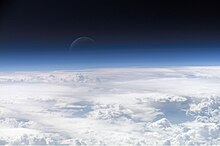Aerospace.
 Aerospace is the human effort in science, engineering and business to fly in the atmosphere of Earth (aeronautics) and surrounding space (astronautics). Aerospace organisations research, design, manufacture, operate, or maintain aircraft and/or spacecraft. Aerospace activity is very diverse, with a multitude of commercial, industrial and military applications.
Aerospace is the human effort in science, engineering and business to fly in the atmosphere of Earth (aeronautics) and surrounding space (astronautics). Aerospace organisations research, design, manufacture, operate, or maintain aircraft and/or spacecraft. Aerospace activity is very diverse, with a multitude of commercial, industrial and military applications.Aerospace is not the same as airspace, which is the physical air space directly above a location on the ground. The beginning of space and the ending of the air is considered as 100 km above the ground according to the physical explanation that the air pressure is too low for a lifting body to generate meaningful lift force without exceeding orbital velocity.
Overview.
Along with these public space programs, many companies produce technical tools and components such as spaceships and satellites. Some known companies involved in space programs include Boeing, Airbus Group, SpaceX, Lockheed Martin, MacDonald Dettwiler and Northrop Grumman. These companies are also involved in other areas of aerospace such as the construction o
aircraft.
History.
Modern aerospace began with George Cayley in 1799. Cayley proposed an aircraft with a "fixed wing and a horizontal and vertical tail," defining characteristics of the modern airplane.The 19th century saw the creation of the Aeronautical Society of Great Britain (1866), the American Rocketry Society, and the Institute of Aeronautical Sciences, all of which made aeronautics a more serious scientific discipline. Airmen like Otto Lilienthal, who introduced cambered airfoils in 1891, used gliders to analyze aerodynamic forces.The Wright brothers were interested in Lilienthal's work and read several of his publications.They also found inspiration in Octave Chanute, an airman and the author of Progress in Flying Machines (1894).It was the preliminary work of Cayley, Lilienthal, Chanute, and other early aerospace engineers that brought about The first powered sustained flight at Kitty Hawk, North Carolina on December 17, 1903, by the Wright brothers.War and science fiction inspired great minds like Konstantin Tsiolkovsky and Wernher von Braun to achieve flight beyond the atmosphere.The launch of Sputnik 1 in 1957 started the Space Age, and on July 20, 1969 Apollo 11 achieved the first manned moon landing.In 1981, the Space Shuttle Columbia launched, the start of regular manned access to orbital space. A sustained human presence in orbital space started with "Mir" in 1986 and is continued by the "International Space Station". Space commercialization and space tourism are more recent focuses in aerospace.
IF ANY SPECIAL QUERY TO THIS BLOG CLICK HERE.
VISIT TO SEE CONFIDENTIAL DESIGNS.



No comments:
Post a Comment